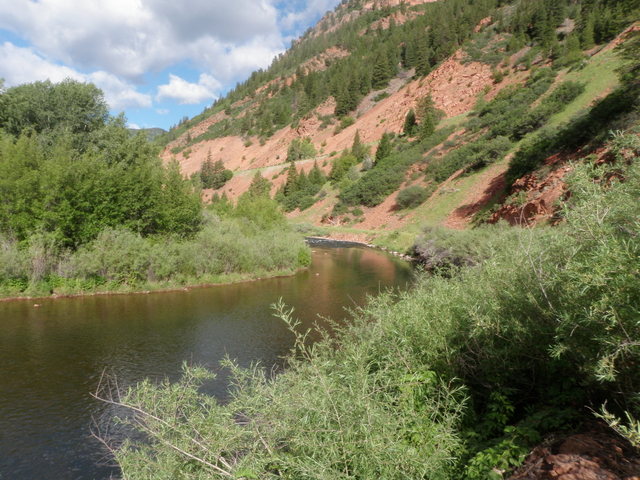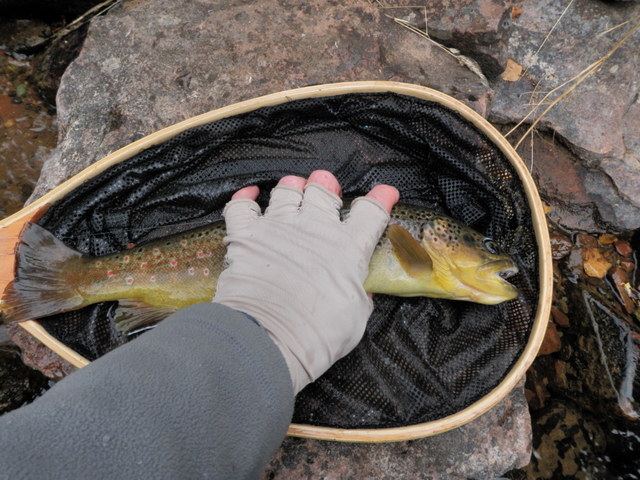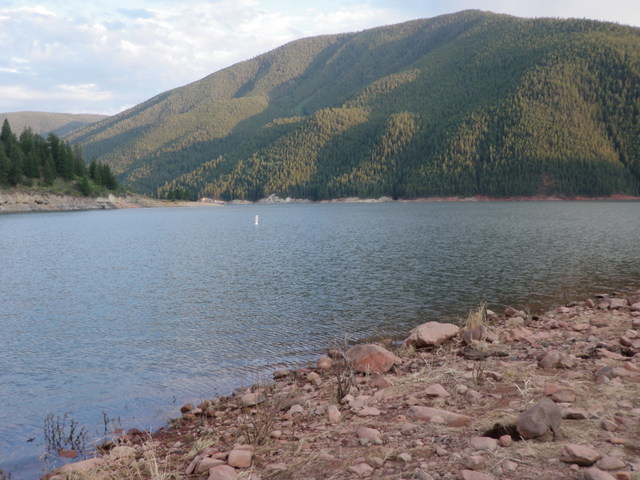Time: 7:00AM – 9:00AM; 11:00AM – 4:00PM
Location: Big Bend just below the dam and later between mile marker 3 and 4
Fish Landed: 10
Frying Pan River 06/27/2014 Photo Album
I’ve read significant amounts of literature about the Frying Pan River, and one of the most frequently mentioned places is the Toilet Bowl. The Toilet Bowl is located where water gushes from the bottom of Reudi Reservoir and forms a huge swirling bowl. One of the prevalent foods that flush through from the dam are mysis shrimp; a small translucent freshwater crustacean. According to written accounts, huge trout reside in the Toilet Bowl and gorge on the mysis shrimp that pour from the outlet of the dam.
My new fishing friend, Danny Ryan, apparently also read these stories, and he was anxious to explore the iconic Frying Pan hole on Friday morning. We were camping at Reudi Reservoir within a couple miles of the bowl, and Danny only had the morning available to fish before he needed to return to Denver and pack for a two week work assignment in Alaska. Why not get up early and head to the Toilet Bowl and secure a spot before the hordes arrived later in the morning? This became our plan as we slid into our tents and sleeping bags on Thursday evening.
I woke up at 6:15, and as I climbed out of the tent, Danny stuck his head out of his tent and greeted me. Clearly this young man was not going to oversleep. For the first time in my life I went from my sleeping bag to my waders without any intermediate step. We jumped into Danny’s Camry and made the short trip to the parking lot, and we were disappointed to discover a white pickup truck occupying the first slot closest to the river. In spite of our best efforts, another fisherman had beaten us to the spot. Several milk crates were on the ground next to the truck, so I hypothesized that the fishermen were still sleeping, but before I could suggest anything else, Danny jumped from the car and ran to a point overlooking the Toilet Bowl.
In a bizarre coincidence, Danny recognized the pickup truck as belonging to another Instagram acquaintance named Justin who goes by the screen name of Screamingdrag. Danny has only lived in Colorado for a year and knows only three or four other fishermen and had somehow stumbled into one of those fishermen at the Toilet Bowl at 7AM on a Friday morning in June. After Danny and Justin hugged like long lost brothers, Justin invited us to join him at the Toilet Bowl, but we decided to opt for a bit more space and chose our second choice; the Big Bend pool just downstream. I think Danny and I both felt that Screamingdrag and his friend deserved to have the Toilet Bowl to themselves as they drove all night and slept in their pickup truck next to the river to obtain first rights.
Danny and I crossed the river in some shallow flats that separated the Toilet Bowl and Big Bend and configured our lines to fish a mysis shrimp and zebra midge larva. It was quite chilly early in the morning particularly in the shadows created by the steep canyon wall, and we were standing in cold water just released from the bottom of the dam that probably registered 45 degrees on a stream thermometer. I began to drift my nymphs at the top of the large pool, and Danny took a position near the tail. It was strangely silent as I flipped cast after cast to the head of the pool and allowed the tandem subsurface offerings to dead drift through the slow moving water.
As this was taking place I began to notice very sporadic bulges near the surface and occasional rises. An hour of dredging with the nymphs failed to interest any fish, so I removed the flies, split shot and strike indicator and tried a black parachute ant. Previous experience has taught me that trout love ants and often sip them opportunistically even if they do not represent the predominant food source. This was a great train of thought, but it didn’t produce a fish. I’d seen a fair number of small caddis flitting about on Thursday, so I removed the ant and tied on a size 16 gray deer hair caddis and covered the top one half of the pool with this imitation. Again my strategy was soundly rejected.
By 8:30AM Danny and I met up and compared notes and discovered that neither of us had landed a fish or even experienced a refusal. Two hours of fishing in Big Bend allowed me to improve my stack mending technique, but that was the most positive outcome. Both of us were feeling quite hungry after skipping the necessities of life to reach the Toilet Bowl early, so we agreed to return to the campground for some sustenance.
We finished removing our vests and packs and threw our rods in the car, when Danny remembered that he needed to say goodbye to Screamingdrag, so he darted off to the edge of the parking lot. Apparently Justin and Danny have some sort of sensory connection, because at that very moment Sceamingdrag appeared on the other side of the stream and called out Danny’s name. Justin had spotted some nice fish and was returning to the parking lot to recruit Danny to “catch the biggest fish of his life”. Danny asked if he could use Screamingdrag’s rod, and Justin agreed, so off they went to the channel on the far side of the Toilet Bowl where a small stream joins the Frying Pan and creates a wide slow-moving lagoon.
I waited for twenty minutes or so and killed time by walking back to Big Bend and taking some photos. Eventually the two Instagram buddies appeared, and Danny announced that he had in fact caught the largest fish of his life, a 21″ cutbow that Screamingdrag guided him to. Justin invited me to return later in the weekend, and he would put me on a similar fish, and then we said our goodbyes and returned to the campground. Danny’s last hurrah before heading to Alaska proved to be quite rewarding.
Jane prepared a delicious breakfast of scrambled eggs, and then Danny packed up his tent and departed for Denver and beyond. I stayed in my waders as the plan was for Jane to drop me off along the river so she could keep the car and go on a hike to Savage Lake. I made a lunch and shoved it in my backpack along with my raincoat, and then we made the drive back downstream along the river. Because there weren’t any large hatches at the end of June, I was convinced that I could catch fish with buggy flies anywhere along the Frying Pan River, so I decided to explore some new water. I asked Jane to pull into a large pullout above mile marker 3, and I planned to hike downstream to the first available path and then fish upstream to whatever point I could reach by late afternoon. Jane agreed to return to the drop off point after her hike, and then I would loop back and meet her there.
I held to my plan and hiked downstream to a place where the river curved back toward the road and away from some spectacular vertical red cliffs. Here I found a faint path through the brush that led to the river. I began my second fishing venture of the day with the tried and true Chernobyl ant and hares ear nymph, but this combination did not produce, so I added a salvation nymph to the point. The salvation nymph is becoming the rock star of 2014, and Friday would prove to be no different than earlier outings, as I landed three medium size browns before lunch on the attractor nymph.
At 12:30 the sun was high and the air warm so I decided to take a break to eat my lunch. I found a nice perch on a huge red rock that jutted into the river below the pullout where Jane dropped me off. I observed the nice deep pool in front of the rock and the riffle at the head of the pool, but I didn’t see any insect activity or active fish. After lunch I slid down the side of the rock and carefully maneuvered to a position where I could cast to the seam created by the riffle at the drop off to the deep hole. On the third or fourth cast I spotted a swirl near the Chernobyl ant and set the hook only to discover that I foul hooked a pretty 14 inch rainbow trout. I was disappointed but pleased to see a fish attracted to the surface fly.
I continued fishing the left bank, but only landed one 12-13 inch brown between 12:30 and 3:00PM as the bright sun and warm temperatures made this an unusually slow period. By 3PM the periodic clouds became larger and the wind stronger, but I was never concerned about rain. The cloud cover did, however, provoke a very sparse blue winged olive hatch so I moved the salvation nymph to the top subsurface fly position and then knotted a size 20 soft hackle emerger as the point fly. This paid a small dividend as a twelve inch brown attacked the emerger in a shallow riffle below a small island.
The bank along the left channel next to the island appeared to be nearly impassable due to dense vegetation, so I waded up the smaller south channel to get above the island. Over the next hour I moved fairly quickly between attractive locations and added five additional trout to my count. All these fish attacked the salvation nymph, and the net felt the weight of a fourteen inch brown and a thirteen inch rainbow. It’s not clear whether the increased catch rate resulted from the overcast skies or the difficult access to this stretch of river, but nevertheless I enjoyed the fast action immensely.
By 4:10PM I reached a point where I could ascend the steep bank and reach the shoulder of the road, so I took advantage and made the climb. I quickly hiked back along the road to the large pullout where Jane dropped me off, and there I found her reading in her new camp rocking chair. I changed out of my waders and returned my rod to its tube, and we continued on to Basalt where we enjoyed beers and appetizers on the deck at the Riverside Cafe. It was an appropriate ending to a fun day on the Frying Pan River.










































